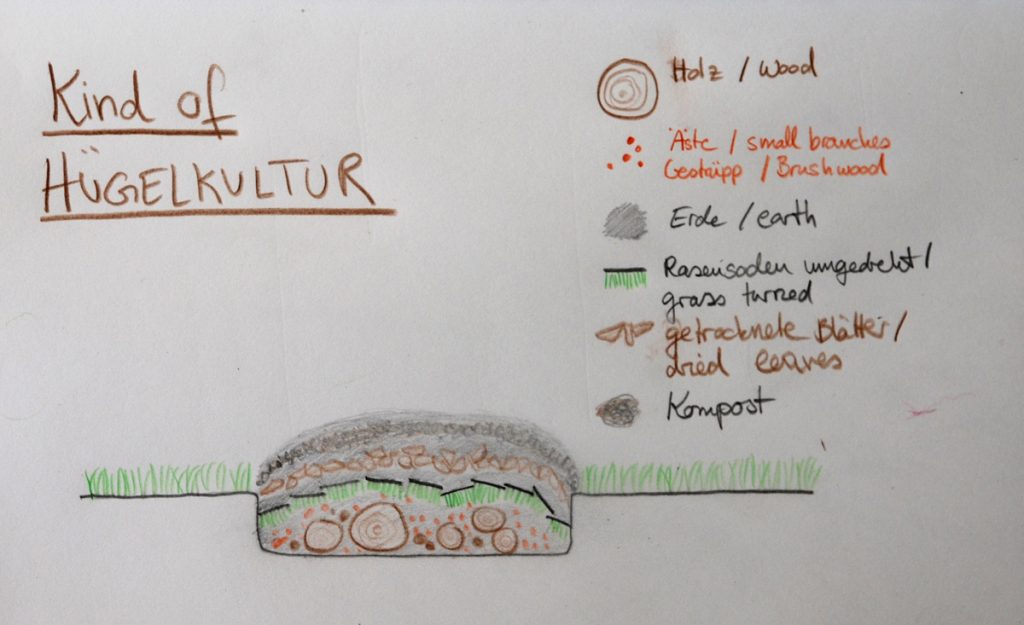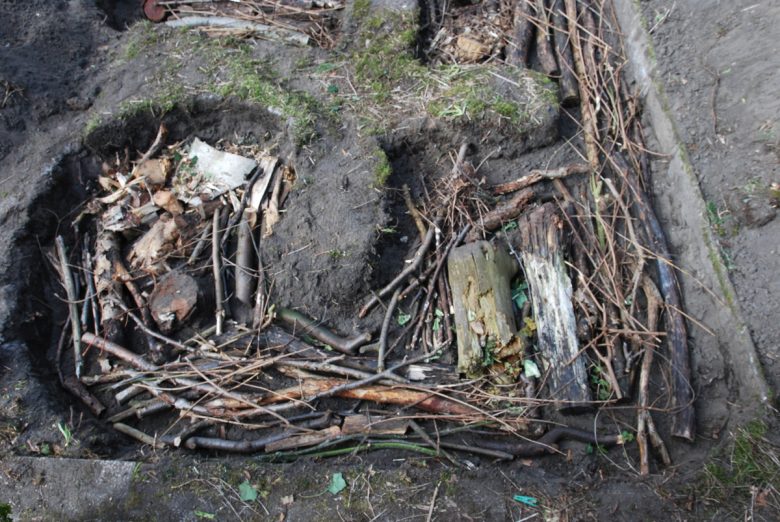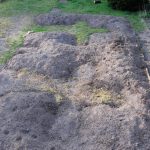UPDATE 2nd September 2016:
For the next time that I will make garden beds in a small project like our garden, I would use more simple no-dig techniques. Just layering material like card board, compost and straw in this order directly on the grass in autumn for example. Next spring the grass underneath will have died and the beds are ready to be planted in. I do think there are benefits for Hugelkulture and one would be if you have a lot of space and a lot of material that you have no idea what to do with. For example many old tree trunks and compost and leaves. I personally would use these garden beds then also for planting berries and trees on them.
What I did observe during the last two seasons with the Hugelkulture garden beds was that there where way more ants than what I was used to in other kind of garden beds. I can´t really say though, if the ants would have been there anyway. I also observed voles that seemed to have found a comfortable home in the depth of the beds, maybe in the cavities between tree trunks.
Two other things that come to my mind when considering our Hugelkulture garden beds are, that the hill shape is drying out faster in the sun than beds that are at ground level. The mulch we used was also blown away more easily due to the hill shape.
Dear friends,
last week we finally finished the Hugelkultur garden beds. It took us quite a while, because we dug very deep and buried half a forest in them.
Hugelkultur garden beds belong to the group of garden beds, where you put a lot of compostable material inside your garden bed to achieve nutrient rich soil with the decomposing over time. „Hügel“ is a german word and means something like „small hill“. There are also other sorts of garden beds that use this principle and they are all non tilling garden beds. For example, there are lasagna garden beds, raised beds and there is sheet mulching. All of these techniques layer different materials and use decomposing of the material on the spot, in the garden bed.
For our garden beds we used logs, small branches, turned grass sods, earth, leaves and compost. In this order. Later I read, that it is recommended to sprinkle calcium and minerals in between the layers [1]. We only mixed the topmost layer with minerals. We resigned to use extra calcium, because a ph-test we did showed no over acidic soil. Before beginning to dig, I „painted“ the area with sand. Sand is a suitable painting device for the garden. For the building of the garden beds I organised a meetup and it was a lot of fun. We where a team of four: Marina, Mathieu, Jan (from the hamburg permaculture meetup group) and me.

Hugelkultur garden beds have a lot of advantages. First of all, when facing poor soil, they are a good technique to improve the soil tremendously. Over time the components layered in it decompose and this sets free the nutrients stored in the material. The Hugelkultur garden bed can be rich in nutrients over a period of five years [2]. The wooden logs serve also by storing humidity, which means you have to water the garden beds less often. The whole thing also heats up, which can enlarge the planting season. Another advantage of these garden beds is that the hilly shape enlarges the amount of planting space.
Reflections
One big concern I had about these garden beds is, that by building them we would completely mix up all the soil life that was in the ground. By digging deep and turning things upside down and so on. But as we only do this once and then never again till or dig them, I found it would be ok. The purpose is to build healthy soil, but the beginning might destroy some of the existing soil life. When building the garden beds we dug very deep. It is not necessary to dig so deep and next time I would dig less, because it saves a lot of work. Another thing I learned for future actions like this is to plan them more sincerely. To have a good idea about the dimensions, the construction and the ingredients. This is true for every project to come. As we worked in a team of four, I found myself in the position of the coordinator, which challenged me a lot. So I also want to work on my coordinating skills. One thing I did not realise early enough for example, was to plan where to put the dug out material. What we did then was to cover all the gross sods we dug out with a lot of earth, so we had to dig them out again later on.
But the overall experience was fantastic and hopefully these garden beds will serve us with improved soil and a lot of nutrients over time.
Thanks to all you helpers!
(1) (2) Praxis Biogarten; Naturgemäß gärtnern, leicht gemacht; Gisela Keil







Great post ! I love to see the planning and the evolution of the garden beds construction 🙂
Are there more adapted for specific plants ?
How do you plan the rotation of the cultures with such a structure ?